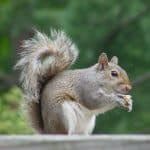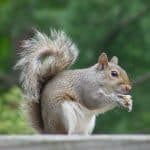Votre panier est actuellement vide !

The squirrel
There are several species of squirrels in Quebec.The grey squirrel is found in cities and suburbs as well as in leafy or mixed forests (including conifers and hardwoods).It wears a coat tinged mainly with gray, especially as winter approaches.As with similar species, the ventral part is rather white.Black squirrels are common, especially when traveling further north.The red squirrel is smaller, with a shorter tail and brown fur.
Latin Name: Sciuris carolinensis
Description:There are several species of squirrels in Quebec.The gray squirrel is seen in cities and suburbs as well as in leafy or mixed forests (including conifers and hardwoods).It wears a coat tinged mostly gray, especially as winter approaches. The red squirrel is smaller, its tail is shorter and its brown coat is reddish in winter and olive in summer. It can be found alongside the grey squirrel, but it is more associated with coniferous (or mixed) forests, and can also be seen around buildings. These squirrels can be differentiated from flying squirrels (southern flying squirrels and northern flying squirrels) by a fold of skin that connects the front leg to the back leg on each side of the body, allowing them to glide. Their tails are also said to be flatter, and they are sometimes found in attics and buildings. The striped chipmunk is smaller, has two white lines on its back delimited by black lines. It also has a smaller tail and it is less bushy.It lives almost exclusively on the ground.
Reproduction:The female raises her young alone. From March to August, she may have one or two litters,each with an average of three young. The young have no hair at birthand their eyes are closed.The female covers them with nest materials when she is away.
Habits:The gray squirrel climbs trees for protection, shelter and food. It seeks the buds (in late winter and spring), acorns, nuts, achenes (fruit of the beech), samaras of maple and elm, the cambium of trees (part of the trunk under the bark), berries as well as insects, eggs and fledglings.In the summer, it makes spherical shelters using tree leaves and twigs that it gathers at the branches. They may also use a woodpecker hole in a tree or chew the insertion point of a rotten branch to make a cavity in which they will nest. They bury fruit (acorns, for example) separately, which they keep in reserve for the winter and which they will find again thanks to their keen sense of smell. The grey squirrel remains active in winter and can take shelter in a cavity inside a tree. Unlike nocturnal flying squirrels, they are active during the day, but at the coolest time of the day in the summer and at the warmest time of the day in the winter. The squirrel is primarily attracted to wooded areas or trees, but may chew through shingled roofs or wood to get into an attic where it will sometimes build a nest. They can also enter a house through the chimney or fireplace. The damage it causes can be significant, as it will chew through electrical wires or wander into hard-to-reach places, or it will chew through mattresses and blankets if it gets into a cottage.It is usually possible to see it or hear the noise it makes, and it is sometimes possible to notice its oval-shaped droppings (about 1 cm long), the holes it has chewed, or the remains of its food reserves. When they bury their food reserves, they also damage lawns. In general, squirrels contribute to the reforestation of natural environments because they forget some of the seeds they bury. Squirrels do, however, interfere with the growth of trees by feeding on their buds and bark. They also prey on the tubing where maple water flows to the sugarhouse.
Prevention:The best way to prevent squirrels from entering the home is to block openings, replace broken windows and inspect other structures that may give them access to a building. These entry points are often located high up so that they are not noticed, but the only exit point should not be blocked if the animal is already inside. It is preferable to install plastic structures in the shape of an inverted funnel on the posts that support bird feeders or nesting boxes so that the seeds or young birds do not become accessible to the squirrels. They are able to chew through wood to enlarge the entrance hole of birdhouses. Some authors suggest cutting off the branches that allow them to climb on the roof. Peanuts (or peanut butter), nuts, sunflower seeds, corn, grapes, and orange or apple slices have been found to be effective baits. It is best to allow the animal to become accustomed to the bait before activating the trap. Note that some localities require a capture permit. Be careful not to reach out to the animal, as it often bites.
Need help with a capture?
